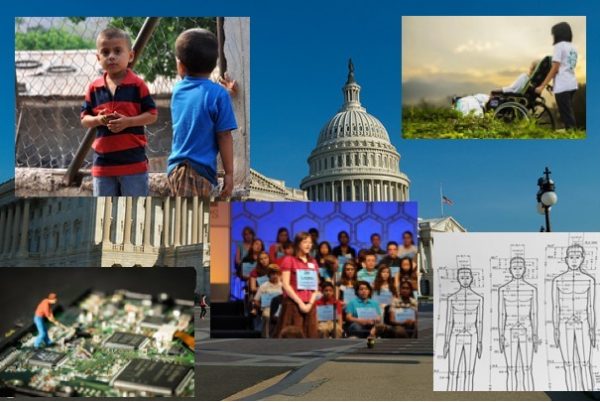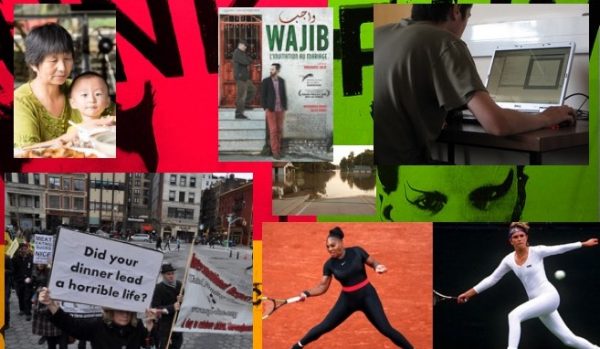 Happy Friday and welcome back! This week we’ve got a new special feature on diversity and wealth in the U.S. Congress, social science research on the migration of unaccompanied minors, and how social media can be a double-edged sword.
Happy Friday and welcome back! This week we’ve got a new special feature on diversity and wealth in the U.S. Congress, social science research on the migration of unaccompanied minors, and how social media can be a double-edged sword.
Special Feature:
“Diversity and Wealth in Congress Today,” by Richard Zweigenhaft. In our latest feature, Zweigenhaft examines how the diversity of Congress and the wealth of its members has changed over time.
There’s Research on That!:
“The Rationale and Risks of Child Migration,” by Lucas Lynch. In light of recent media attention on unaccompanied minors who migrate to the United States, we rounded up social science research on the difficult decision to migrate and the experiences of those who do.
Discoveries:
“Spelling Bees to Secure Straight ‘A’s’,” by Neeraj Rajasekar. New research in The Sociological Quarterly finds that a belief in the need to competitive in the modern world drives many Asian-American parents to emphasize educational success for their children.
Clippings:
“How Class Privilege Shaped Kavanaugh,” by Caity Curry. In an op-ed for The Washington Post, Shamus Khan provides his take on how class privilege shaped many of Brett Kavanaugh’s actions.
“Social Media is a Double-Edged Sword,” by Allison J. Steinke. In an article published by MIT Technology Review, Zeynep Tufekci uses her research on political upheaval and social media to show how digital connectivity can enable large-scale movements but also has a “dark side.”
From Our Partners:
Sociological Images:
“Who Gets to Change the Subject?” by Evan Stewart.
Contexts:
“Nonviolent Protests and the Formation of Democracies,” by Hannah N. Kleman.
Council on Contemporary Families:
“How Marital Transitions Affect Perceptions about Family Caregiving Responsibilities,” by Lawrence H. Ganong and Marilyn Coleman.
And a Few from the Community Pages:
- Cyborgology ponders the potential consequences of ZOZO’s custom-fit clothing app.
- Center for Holocaust & Genocide Studies remembers Fern Badzin.
- Girl w/ Pen! interviews Tasia Clemons.

 Welcome back! This week at TSP we’ve got research on the rise of data journalism, prison labor, and the Portuguese punk scene. You can also find sociologists’ takes on vegan social movements and how natural disasters increase racial inequality.
Welcome back! This week at TSP we’ve got research on the rise of data journalism, prison labor, and the Portuguese punk scene. You can also find sociologists’ takes on vegan social movements and how natural disasters increase racial inequality. Here at TSP headquarters, we’re settling into the semester and the cool fall weather. This week we’ve got social science research on race and social assistance in the United States, how the internet changed the dating game, and the lives saved and lost by incarceration.
Here at TSP headquarters, we’re settling into the semester and the cool fall weather. This week we’ve got social science research on race and social assistance in the United States, how the internet changed the dating game, and the lives saved and lost by incarceration. Welcome back to another week of sociology at TSP! This week you’ll find new research on graffiti as a subculture, how the term, “white trash” reinforces white supremacy, and reflections on why U.S. women’s soccer fans are mostly White.
Welcome back to another week of sociology at TSP! This week you’ll find new research on graffiti as a subculture, how the term, “white trash” reinforces white supremacy, and reflections on why U.S. women’s soccer fans are mostly White.

 Here at TSP headquarters, we’re gearing up for another fall semester starting in just a couple weeks — that means welcoming new board members, producing more in-house content, and highlighting awesome writing by our partners and community pages! Until then, we’ve got social science research on the “Hispanic Paradox,” new research on what makes a valuable potential partner for marriage, and insight on how childhood trauma makes reentry more difficult.
Here at TSP headquarters, we’re gearing up for another fall semester starting in just a couple weeks — that means welcoming new board members, producing more in-house content, and highlighting awesome writing by our partners and community pages! Until then, we’ve got social science research on the “Hispanic Paradox,” new research on what makes a valuable potential partner for marriage, and insight on how childhood trauma makes reentry more difficult. Happy Friday! Glad to have you back with us. This week we’ve got a new special feature on boomtowns, social science research on sexual violence in detention, and an interview with Dr. Hui Wilcox on her work on dance.
Happy Friday! Glad to have you back with us. This week we’ve got a new special feature on boomtowns, social science research on sexual violence in detention, and an interview with Dr. Hui Wilcox on her work on dance. Greetings from Philadelphia! Many of us at TSP are in town for the annual American Sociological Association meeting, but that doesn’t mean we’ve been slacking on content! This week we’ve got social science research on the purposes of punishment, how lead poisoning can lead to antisocial behavior, and why children’s self-control isn’t a good measure of future success.
Greetings from Philadelphia! Many of us at TSP are in town for the annual American Sociological Association meeting, but that doesn’t mean we’ve been slacking on content! This week we’ve got social science research on the purposes of punishment, how lead poisoning can lead to antisocial behavior, and why children’s self-control isn’t a good measure of future success. Happy Friday! As we move into August, we rounded up research on abortion providers before Roe v. Wade, the ways country context influences web journalism analytics, and why so many people watch disaster coverage.
Happy Friday! As we move into August, we rounded up research on abortion providers before Roe v. Wade, the ways country context influences web journalism analytics, and why so many people watch disaster coverage.